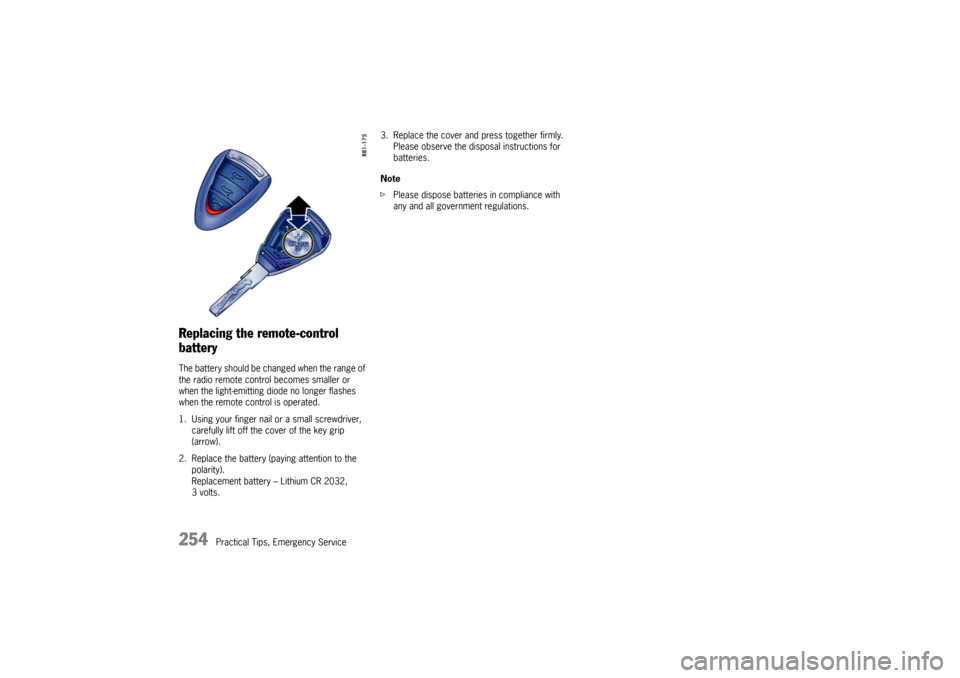2010 PORSCHE BOXSTER S battery replacement
[x] Cancel search: battery replacementPage 17 of 294

Operation, Safety
15
Keys fPlease see the chapter “ALARM SYSTEM, PAS-
SENGER COMPARTMENT MONITORING” on
Page 25.
f Please see the chapter “CENTRAL LOCKING IN
CARS WITHOUT ALARM SYSTEM” on Page 19.
f Please see the chapter “CENTRAL LOCKING IN
CARS WITH ALARM SYSTEM” on Page 21.
Two car keys are supplied with your Porsche.
These keys operate all the locks on your vehicle.
f Be careful with your car keys: do not part with
them except under exceptional circumstances.
f To avoid battery run-down, always remove the
ignition key from the ignition lock. Emergency operationfPlease see the chapter “EMERGENCY OPERA-
TION – PULLING OUT THE IGNITION KEY” on
Page 74.
Replacement keys Replacement car keys can be obtained only from
your authorized Porsche dealer, and this can
sometimes be very time-consuming.
You should therefore always keep a spare key on
your person.
Keep it in a safe place (e.g. wallet), but under no
circumstances in or on the vehicle.
The key codes of new keys have to be “reported”
to the car control unit by your authorized Porsche
dealer.
A total of 6 car keys can be reported to the control
unit.
Disabling key codes
If a key is lost, the key codes can be disabled by
an authorized Porsche dealer.
All the remaining car keys are required for this pur-
pose.
Disabling the code ensures that the car can be
started only using authorized keys.
Note
f Please note that the other locks can still be
opened with the disabled key.
Immobilizer There is a transponder (an electronic component)
in the key grip, conta ining a stored code.
When the ignition is switch ed on, the ignition lock
checks the code.
The immobilizer can be deactivated and the en-
gine started only using an authorized ignition key.
Switching off the immobilizer
f Insert the ignition key into the ignition lock.
If the ignition is left on for more than 2 minutes
without the engine being started, the immobilizer
is switched on again.
f If this happens, turn the ignition key back to
position 3 (ignition off) before starting the
engine. The immobilizer is switched off again,
and the engine can be started.
f Please see the chapter “IGNITION/STARTER
SWITCH WITH ANTI-THEFT STEERING LOCK”
on Page 72.
Switching on the immobilizer
f Remove ignition key.Security Wheel Bolts fIf wheels have to be removed during a work-
shop visit, do not forget to hand over the sock-
et for the security wheel bolts along with the
car key.
Page 156 of 294

154
Instruments, On-Board Computer, Warnings
System learningThe Tire Pressure Monitoring begins to “learn” the
wheels after a wheel change, wheel transmitter
replacement or update of the tire settings. During
this process, the Tire Pressure Monitoring recog-
nizes the tires and their locations.
The on-board computer displayes the message
“TPM is learning, monitoring not act.”.The Tire Pressure Monitoring requires a certain
amount of time to learn the wheels. During this
time, the current tire pressures are not available
on the on-board-computer:
– The tire pressure warning light remains lit until
all wheels have been learned.
– The display of the tire pressure function of the on-board computer shows lines.
– The required pressures for cold tires at 68 °F (20 °C) are indicated in the Info pressure
display in the tire pressure menu.
Position and pressure information is displayed as
soon as the Tire Pressure Monitoring has as-
signed the wheels identified as belonging to the
vehicle to the correct wheel positions.
The wheel learning process takes place
exclusively when the vehicle is being driven
(vehicle speed above 25 km/h (16 mph)).
f Check the tire pressure for all wheels on the
“Info pressure” display.
f Correct the tire pressure to the required
pressure if necessary.
Changing a wheel and replacing tiresfNew wheels must be fitt ed with radio transmit-
ters for the Tire Pressure Monitoring.
Before tires are changed, the battery charge
state of the wheel transmitters should be
checked at an authorized Porsche dealer.
f Switch the ignition off when changing a wheel.
The tire settings on the on-board computer must
be updated after changing a wheel.
If the tire settings are not updated, the message
“Wheel change? Input new TPM settings!” is
displayed on the on-board computer.
f Update the on-board computer settings when
the vehicle is stationary the next time.
Page 206 of 294

204
Maintenance, Car Care
Fuel Economy Fuel economy will vary depending on where,
when and how you drive, optional equipment
installed, and the general condition of your
car.
A car tuned to specifications and correctly
maintained, will help you to achieve optimal
fuel economy.
fHave your vehicle tuned to specifications.
Air cleaner should be dirt free to allow proper
engine “breathing”.
Battery should be fully charged.
Wheels should be properly aligned.
Tires should be inflated at correct pressure.
f Always monitor your fuel consumption.
f Drive smoothly, avoid abrupt changes in speed
as much as possible.
f Avoid jack rabbit starts and sudden stops.
f Do not drive longer than necessary in the lower
gears. Shifting into a higher gear early without
lugging the engine will help save fuel.
f Prolonged “warm up” idling wastes gas. Start
the vehicle just before you are ready to drive.
Accelerate slowly and smoothly.
f Switch off the engine if stationary for longer
periods. f
Any additional weight carried in the vehicle re-
duces fuel economy. Always keep cargo to a
minimum and remove all unnecessary items.
f Organize your trips to take in several errands
in one trip.
f All electrical accessories contribute to in-
creased fuel consumption.
f Only switch on the air conditioning when neces-
sary.
f Do not drive with the Ro of Transport System
mounted unless you need it.
The EPA estimated mpg. is to be used for
comparison purposes, actual mileage may
be different from the estimated mpg.,
depending on your driving speed, weather
conditions and trip length. Your actual
highway mileage will probably be less than
the estimated mpg.
f Please observe all local and national speed
limits.
Operating your Porsche in other
Countries Government regulations in the United States and
Canada require that automobiles meet specific
emission regulations and safety standards. There-
fore, cars built for the U.S. and Canada differ from
vehicles sold in other countries.
If you plan to take your Porsche outside the conti-
nental limits of the United States or Canada, there
is the possibility that
– unleaded fuel may not be available;
– unleaded fuel may have a considerably lower
octane rating. Excessive engine knock and se-
rious damage to both engine and catalytic con-
verters could result;
– service ma y be inadequa te due to lack of prop- er service facilities, tools or diagnostic equip-
ment;
– replacement parts may not be available or very difficult to get.
Porsche cannot be responsible for the
mechanical damage that could result
because of inadequate fuel, service or parts
availability.
If you purchased your Porsche abroad and want to
bring it back home, be sure to find out about ship-
ping and forwarding requirements, as well as cur-
rent import and customs regulations.
Page 253 of 294

Practical Tips, Emergency Service
251
Winter operation The capacity and ability of the battery to store
power decreases at low outside temperatures.
Moreover, the battery is more heavily loaded in
winter months, e.g. by the heated rear window,
more frequent use of additional lights, the fans
and the windshield wipers, etc.
f Have the battery checked before the start
of winter.
Maintenance note
Keep the battery well charged to prevent it
from freezing.
A discharged battery can freeze at 23 °F (--5 °C),
but a fully charged battery only freezes at -- 40 °F
(--40 °C).
A frozen battery must always be thawed before
connecting jump leads.
Replacing battery The service life of the batt ery is subject to normal
wear; it depends greatly on care, climatic conditi-
ons, and driving conditions (distances, loads).
f Only use an original Porsche battery, with the
correct part number, as a replacement.
f Please observe the disposal instructions for
batteries.
Putting vehicle into operationAfter the battery is co nnected or after an exhaus-
tively discharged battery is charged, the multi-
functional PSM light lights up on the instrument
panel and a message appears on the on-board
computer to indicate a fault.
This fault can be remedied with a few simple
steps:
1. Start the engine.
2. With the vehicle stationary, perform a few steering movements to the left and right and
then drive a short distance in a straight line
until the multifunctinal PSM light goes out and
the message on the on-board computer
disappears.
3. If the warnings do not disappear, then:
Drive carefully to the nearest authorized
Porsche dealer.
Have the fault remedied.
4. After the warnings disappear: Stop the vehicle in a suitable place.
f Perform adaptation of the power windows:
Please see the chapter “STORING END
POSITION OF THE WINDOWS” on Page 28.
Page 256 of 294

254
Practical Tips, Emergency Service
Replacing the remote-control
battery The battery should be changed when the range of
the radio remote control becomes smaller or
when the light-emitting diode no longer flashes
when the remote control is operated.
1. Using your finger nail or a small screwdriver, carefully lift off the cover of the key grip
(arrow).
2. Replace the battery (paying attention to the polarity).
Replacement battery – Lithium CR 2032,
3volts. 3. Replace the cover and press together firmly.
Please observe the disposal instructions for
batteries.
Note
f Please dispose batteries in compliance with
any and all government regulations.
Page 291 of 294

Index
289
PPaintCare .......................... ................ 213, 215
Data............... ......................... ........... 275
ParkAssistant ...................................... ......... 70
Parking
PDK transmission.... ............................ 179
Parking aids ............... ............................ 70, 71
Parking brake ............. .................................. 55
Warning light .......... .............................. 56
Parking light ............... ...................... 78, 80, 81
Particle filter ........... .................................... 211
Passenger compartment monitoring............... 25
PDK transmission ....... ................................ 174
Drive-Off Assistant... ............................ 173
Driving in winter .. ................................ 179
Faults................................................. 175
Kickdown ................... ........................ 177
Launch Control ....... ............................ 177
Manual selection mode ........................ 178
Reduced driving program .................... 180
Selector lever emerge ncy release ........ 269
Selector lever positi ons ....................... 176
Shifting gears on the steering wheel ..... 177
Sport mode ................ ........................ 176
Transmission fluid ............................... 211
Warning messages.. ............................ 180
Pen holder.................. .................................. 90
Plastic parts ............................................... 218 Care .................................................. 218
Platform lift ................ ................................ 242
Porsche Active Suspension Management
(PASM) ................................................ ......... 66
Sport mode ................ .......................... 66 Porsche Ceramic Composite Brake (PCCB) .......4
Porsche Communication Management (PCM)...97
Porsche Doppelkupplung
(PDK) ....................174
Drive-Off Assistant . ..............................173
Driving in winter .... ..............................179
Faults ....................... ..........................175
Kickdown.................. ..........................178
Launch Control.......... ..........................174
Manual selection mo de ........................178
Reduced driving program.....................180
Selector lever emergency release ........269
Selector lever position .................174, 176
Shifting gears on the steering wheel .....177
Sport mode .............. ..........................176
Transmission fluid ...............................211
Porsche Stability Manage ment (PSM) ..............63
Information light .... ................................65
Power steering fluid le vel .....................211, 281
Power windows ............. ........................18, 182
Practical tips ............ ..................................222
Putting vehicle into op eration.
......................251RRadiator fan..........................................76, 198
Radio reception ........ ....................................97
Rain sensor .............. ....................................82
Range on remaining fuel ......................131, 160
Rear fender
Retractable ........... ................................67
Rear lid ........................ ....................92, 93, 95
Rear spoiler .................. ..........................67, 68
Rear view mirrors...... ..............................29, 30
Rear window defogger ...........................31, 113
Rear window heating . ..................................113 Recirculating-air butt
on ............................... 110
Refuelling ........................................ .......... 206
Relays ......................... .............................. 245
Remote control ............ ................................ 16
Readiness ................ ............................ 17
Replacing battery ..................... .......... 254
Standby funktion .. ................................ 17
Synchronization.... ................................ 17
Replacement key.......... ................................ 15
Replacing bulbs....... ................................... 257
Replacing wiper blades ............................... 212
Retractable spoiler .. ..................................... 67
Rims Diameter ................. .......................... 233
Rim width................. .......................... 233
TPM sensors............ .......................... 229
Running in.................... ................................ 10
SSafety belts ............ ..................................... 42
Cleaning ............................................ 219
Tensioner ............................................ 42
Warning light ............ ............................ 43
Safety compliance sticker ........................... 274
Sealing set .................. .............................. 240
Seals .......................... .............................. 218
Care ........................ .......................... 218
Seat
Adaptive sports se at............................. 33
Adjustment .......................................... 32
Comfort seat ........... ............................ 33
Heating.................... ............................ 37
Memory ................... ............................ 35
Position ................... ............................ 32